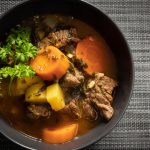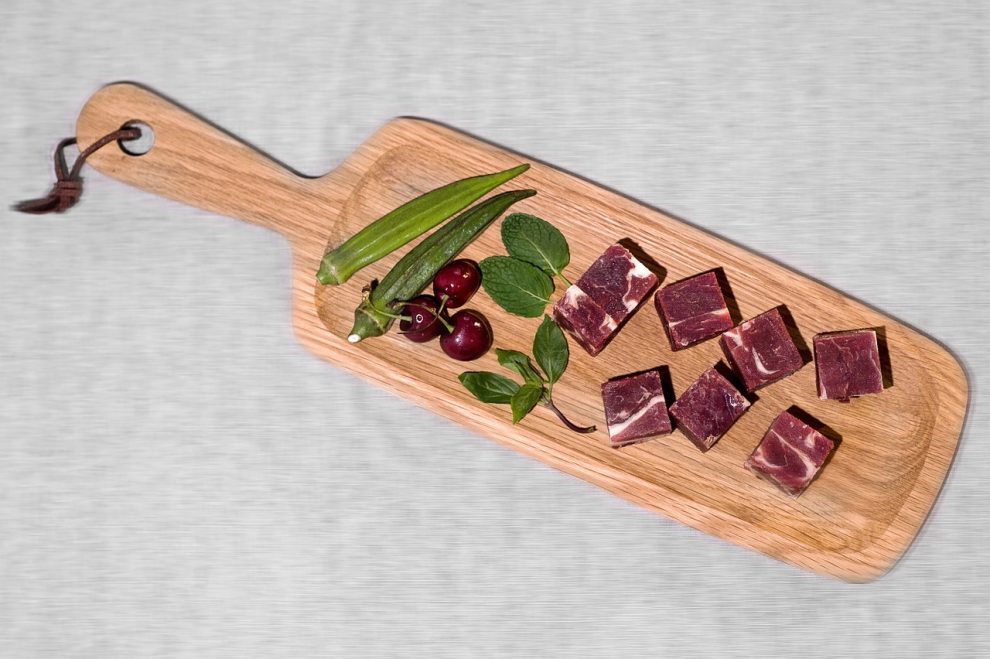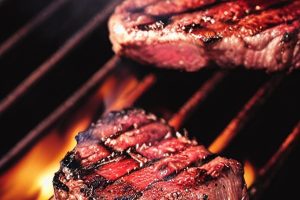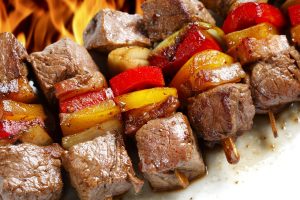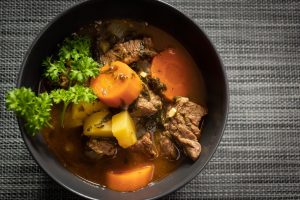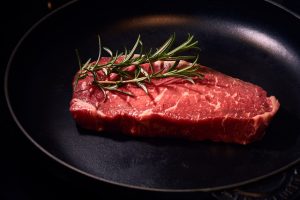“Savoring Szechuan: A Spicy Twist on Moo Shu Beef”
Szechuan cuisine is renowned for its bold flavors and fiery spices that tantalize the taste buds. One dish that perfectly encapsulates the essence of this cuisine is Moo Shu Beef. Originating from the Szechuan province in China, this dish combines tender strips of beef, crisp vegetables, and a spicy sauce to create a mouthwatering masterpiece. If you’re a fan of spicy food and are looking to add a twist to your culinary repertoire, Szechuan-style Moo Shu Beef is the perfect choice.
To prepare this delectable dish, you will need a few key ingredients. First and foremost, the star of the show is the beef. Opt for a lean cut, such as flank steak or sirloin, as it will be easier to slice into thin strips. Next, gather an assortment of vegetables to add texture and flavor. Common choices include cabbage, carrots, mushrooms, and bamboo shoots. These vegetables not only provide a delightful crunch but also complement the spice of the Szechuan sauce.
Speaking of which, the sauce is what sets this dish apart. Szechuan cuisine is known for its liberal use of spices, particularly Szechuan peppercorns and chili peppers. These ingredients lend a numbing and tingling sensation to the taste buds, creating a unique flavor profile. To make the sauce, combine soy sauce, rice vinegar, ginger, garlic, and a generous amount of chili flakes or Szechuan peppercorns.
Now that you have your ingredients ready, it’s time to start cooking. Begin by marinating the beef in a mixture of soy sauce and cornstarch. This will not only infuse the meat with flavor but also help tenderize it. While the beef is marinating, prepare the vegetables by slicing them into thin strips. It’s important to have all your ingredients prepped and ready before you start cooking, as Szechuan cuisine is known for its quick and high-heat cooking methods.
Heat a wok or a large skillet over high heat and add some oil. Once the oil is hot, add the marinated beef and stir-fry it until it’s browned. Remove the beef from the pan and set it aside. In the same pan, add the vegetables and stir-fry them until they are crisp-tender. Be careful not to overcook them, as their vibrant colors and crunchiness should be preserved.
Once the vegetables are cooked to perfection, return the beef to the pan and pour in the Szechuan sauce. Stir everything together, ensuring that the beef and vegetables are coated in the spicy goodness. Allow the sauce to simmer for a few minutes, allowing the flavors to meld together.
Traditionally, Moo Shu Beef is served with thin pancakes that act as a wrap for the filling. These pancakes are typically made from flour and water and can be found at Asian grocery stores. Alternatively, you can use lettuce leaves or even tortillas as a substitute.
To assemble, place a spoonful of the beef and vegetable mixture onto each pancake and roll it up tightly. The combination of the tender beef, crisp vegetables, and spicy sauce creates a taste explosion that will leave you craving for more.
In conclusion, Szechuan-style Moo Shu Beef is a spicy twist on a classic dish that will delight your taste buds. Its combination of bold flavors, fiery spices, and tender beef makes it a standout choice for those who enjoy the heat. So, don’t be afraid to venture into
“Cantonese Delights: Exploring a Traditional Take on Moo Shu Beef”
Cantonese Delights: Exploring a Traditional Take on Moo Shu Beef
Moo Shu Beef is a beloved dish in Cantonese cuisine that has been enjoyed for centuries. This traditional delicacy combines tender strips of beef with a medley of fresh vegetables, all wrapped in delicate pancakes. The result is a harmonious blend of flavors and textures that is sure to delight any food lover.
To create this delectable dish, the first step is to marinate the beef. Traditional Cantonese recipes call for thinly sliced beef to be marinated in a mixture of soy sauce, rice wine, and cornstarch. This not only adds flavor to the meat but also helps to tenderize it, ensuring a melt-in-your-mouth texture.
While the beef is marinating, the vegetables are prepared. Common choices include cabbage, mushrooms, carrots, and bamboo shoots. These ingredients are typically sliced into thin strips, allowing them to cook quickly and evenly. The use of fresh, seasonal vegetables is essential to achieve the authentic Cantonese taste.
Once the beef and vegetables are ready, they are stir-fried in a hot wok. This cooking technique allows for quick and efficient cooking, ensuring that the ingredients retain their vibrant colors and crisp textures. A combination of garlic, ginger, and green onions is often added to enhance the aroma and flavor of the dish.
To complete the Moo Shu Beef experience, the stir-fried mixture is served with thin, delicate pancakes. These pancakes are made from a simple mixture of flour, water, and sometimes eggs. They are rolled out into thin rounds and cooked on a hot griddle until they are soft and pliable. The pancakes provide the perfect vessel for wrapping the beef and vegetable mixture, adding an extra layer of texture to each bite.
Traditionally, Moo Shu Beef is enjoyed as a family-style dish, with everyone at the table helping themselves to the pancakes and filling. Each person can customize their own wrap by adding an additional touch of flavor with hoisin sauce, a tangy and sweet condiment commonly used in Cantonese cuisine.
In conclusion, Moo Shu Beef is a classic Cantonese dish that offers a delightful combination of flavors and textures. Its tender beef, crisp vegetables, and soft pancakes create a harmonious culinary experience that is sure to please any palate. By following traditional Cantonese recipes and cooking techniques, one can truly appreciate the authentic taste of this beloved dish. So next time you’re in the mood for a traditional Cantonese delight, give Moo Shu Beef a try and savor the rich flavors of this timeless delicacy.
“From Shanghai to Shenzhen: Regional Variations of Moo Shu Beef”
Moo Shu Beef, a popular Chinese dish, is known for its delicious combination of tender beef, fresh vegetables, and savory sauce. While this dish is widely enjoyed throughout China, there are regional variations that make it unique to specific areas. In this article, we will explore the differences between Moo Shu Beef in Shanghai and Shenzhen, highlighting the regional variations in ingredients, cooking techniques, and flavors.
In Shanghai, Moo Shu Beef is characterized by its emphasis on simplicity and elegance. The dish typically features thinly sliced beef, marinated in a delicate combination of soy sauce, rice wine, and cornstarch. The beef is then stir-fried with traditional Shanghai-style vegetables such as bamboo shoots, wood ear mushrooms, and scallions. The flavors are subtle and well-balanced, allowing the natural taste of the ingredients to shine through. Shanghai-style Moo Shu Beef is often served with thin pancakes, allowing diners to wrap the beef and vegetables inside, creating a delightful and interactive dining experience.
On the other hand, in Shenzhen, Moo Shu Beef takes on a bolder and spicier flavor profile. The dish is known for its vibrant colors and fiery taste. Shenzhen-style Moo Shu Beef features thicker slices of beef, marinated in a flavorful combination of chili paste, garlic, and Sichuan peppercorns. The beef is then stir-fried with a variety of vegetables such as bell peppers, onions, and carrots, creating a visually appealing dish with a kick of heat. Shenzhen-style Moo Shu Beef is often served with steamed rice, allowing the spiciness of the dish to be balanced by the neutral flavor of rice.
Despite the differences in ingredients and flavors, both Shanghai and Shenzhen offer their own unique take on Moo Shu Beef. Whether you prefer the subtle elegance of Shanghai-style or the fiery boldness of Shenzhen-style, one thing is for certain – Moo Shu Beef is a dish that continues to captivate taste buds across China.
In conclusion, the regional variations of Moo Shu Beef in Shanghai and Shenzhen highlight the diverse culinary landscape of China. From the simplicity and elegance of Shanghai-style to the bold and spicy flavors of Shenzhen-style, each variation offers a distinct and enjoyable dining experience. Whether you find yourself in Shanghai or Shenzhen, be sure to savor the regional take on this beloved Chinese dish.
“Discovering the Bold Flavors of Hunan Moo Shu Beef”
Hunan Moo Shu Beef is a dish that tantalizes the taste buds with its bold and robust flavors. Originating from the Hunan province in China, this dish is a perfect blend of savory and spicy, sure to please even the most discerning palates. In this informative piece, we will explore the distinct characteristics of Hunan Moo Shu Beef, its ingredients, and the traditional cooking techniques that make it a standout dish in Chinese cuisine.
Hunan Moo Shu Beef is known for its rich and complex flavors, which are achieved through the skillful use of a variety of ingredients. The key components of this dish include thinly sliced beef, wood ear mushrooms, bamboo shoots, and bean sprouts. These ingredients are stir-fried together in a wok, allowing the flavors to meld and intensify.
To create the bold and spicy taste that is characteristic of Hunan cuisine, a combination of chili peppers, garlic, and ginger is added to the dish. These aromatic ingredients not only provide heat but also enhance the overall flavor profile. Additionally, the use of soy sauce and rice wine adds depth and complexity to the dish, creating a harmonious balance of flavors.
The cooking technique used in preparing Hunan Moo Shu Beef is also worth mentioning. Traditionally, the beef is marinated in a mixture of soy sauce, cornstarch, and rice wine before being stir-fried. This step not only helps to tenderize the meat but also infuses it with the flavors of the marinade. The vegetables are then added to the wok, followed by the sauce, which is made from a combination of soy sauce, vinegar, and sugar. This sauce adds a tangy and slightly sweet element to the dish, complementing the spiciness of the chili peppers.
The final result is a dish that is visually appealing, with vibrant colors and contrasting textures. The tender beef, crisp vegetables, and chewy wood ear mushrooms create a delightful combination of textures that add depth to each bite. The flavors are bold, with the spiciness of the chili peppers balanced by the umami-rich soy sauce and the tanginess of the vinegar.
In conclusion, Hunan Moo Shu Beef is a dish that showcases the bold flavors and traditional cooking techniques of Hunan cuisine. Its combination of savory and spicy flavors, along with its visually appealing presentation, make it a standout dish in Chinese cuisine. Whether you are a fan of spicy food or simply looking to explore new flavors, Hunan Moo Shu Beef is a dish that is sure to leave a lasting impression.
“Journey through China: Exploring Regional Twists on Moo Shu Beef”
China is a vast country, known for its rich history, diverse culture, and of course, its incredible cuisine. One dish that stands out among the many delectable options is Moo Shu Beef. This traditional Chinese dish has been enjoyed for centuries and is known for its unique combination of flavors and textures. However, what many people may not realize is that Moo Shu Beef can vary greatly depending on the region of China you find yourself in. In this article, we will take you on a journey through China, exploring the regional twists on this beloved dish.
First stop, Beijing. As the capital city of China, Beijing is known for its imperial history and the influence it has had on Chinese cuisine. In Beijing-style Moo Shu Beef, the focus is on simplicity and showcasing the natural flavors of the ingredients. The beef is thinly sliced and stir-fried with a medley of vegetables such as cabbage, carrots, and mushrooms. The dish is then seasoned with a delicate blend of soy sauce, hoisin sauce, and ginger. The result is a light and refreshing version of Moo Shu Beef that highlights the freshness of the ingredients.
Next, we travel to Sichuan province, famous for its bold and spicy flavors. Sichuan-style Moo Shu Beef takes things up a notch with the addition of dried chili peppers and Sichuan peppercorns. These ingredients give the dish a fiery kick that is characteristic of the region. The beef is marinated in a mixture of soy sauce, vinegar, and Sichuan peppercorns before being stir-fried with a variety of vegetables such as bell peppers and bean sprouts. The result is a mouthwatering combination of heat and numbing sensation that is sure to leave a lasting impression.
Moving on to Shanghai, known for its cosmopolitan vibe and fusion of Eastern and Western influences. Shanghai-style Moo Shu Beef is a perfect example of this cultural blend. The dish features tender strips of beef stir-fried with a mix of vegetables including bamboo shoots and wood ear mushrooms. What sets Shanghai-style Moo Shu Beef apart is the addition of Shaoxing wine, a traditional Chinese rice wine that adds depth and richness to the flavors. The dish is typically served with thin pancakes, allowing diners to wrap the beef and vegetables in a delightful, handheld package.
Our final stop on this culinary journey is Guangdong province, home to Cantonese cuisine. Cantonese-style Moo Shu Beef is all about the balance of flavors and textures. The beef is marinated in a combination of oyster sauce, soy sauce, and sugar, giving it a sweet and savory taste. It is then stir-fried with a mix of crunchy vegetables such as water chestnuts and baby corn. The dish is finished off with a sprinkling of sesame seeds for added texture and nuttiness. The result is a harmonious blend of flavors that is both satisfying and comforting.
As we conclude our journey through China, it is evident that Moo Shu Beef is a dish that has been adapted and reinvented in various regions, each with its own unique twist. Whether you prefer the simplicity of Beijing-style, the spiciness of Sichuan-style, the fusion of Shanghai-style, or the balance of Cantonese-style, there is a version of Moo Shu Beef to suit every palate. So why not embark on your own culinary adventure and explore the regional twists on this beloved dish? Your taste buds will thank you.



